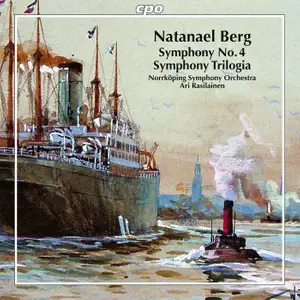
Natanael Berg (1879-1957)
Symphony No.4 ‘Pezzo sinfonico’ (1918)
Symphony No.5 ‘Triologia delle passioni’ (1926)
Norrköping Symphony Orchestra/Ari Rasilainen
rec. 2011, De Geer Hall, Norrköping
cpo 777 665-2 [63]
Natanael Berg’s Symphony No.4 has been recorded before, on Sterling (review) and on Phono Suecia (review) and, for those partial to suite-like charm of no intellectual pretensions, you can hear why. Berg was a military veterinarian – there’s a charming cartoon reprinted in the booklet that shows him taking the pulse of Pegasus – and a good friend of Kurt Atterberg. In 1918 the two composers made a pact to write light symphonies in four movements that lasted no more than 20 minutes, but which included the use of a tuba. Berg’s Fourth Symphony, or ‘Pezzo sinfonico’, duly followed. The pact could have been a prelude to quixotic orchestration and a fair degree of tomfoolery but Berg restrained himself to compose a gossamer, Mendelssohnian effusion, more incidental music than symphonic – I agree with contemporary critics who found it sinfonietta-like – that provides compact pleasure. Berg’s wind writing is accomplished and there’s much warmth in the writing, and a certain cocksure frolicsome quality in the finale, the movement where one can feel the serio-comic presence of the tuba. A bagatelle of a symphony.
Programming the Fourth with the Fifth symphonies allows the listener to journey from the light-hearted and – frankly – rather inconsequential (symphonically speaking) to a much heavier, more philosophical work, from the light to the dark. Premiered by Armas Järnefelt in 1926 it’s subtitled ‘Triologia delle passioni’ and it certainly delivers in respect of passion. It’s in three movements with outer Moderato movements flanking a central slow movement, the music remaining predominantly watchful in its avoidance of extremes. The sombre, dramatic tread of the opening generates a passionate seriousness in the lower strings and brass, and there’s little let-up in its relentless progress. Some of the string muddiness is, I suspect, the fault of the composer’s orchestration. By contrast, the central movement’s lonely wind calls summon up allusions to the Fourth Symphony in their allusive Mendelssohnian qualities, though Berg is sure to encode some terse, striving melodic figures to ensure full contrast and these function as a kind of Fate motif. The finale is boldly conceived, full of brassy imperatives and swaggering confidence complete with reflective paragraphs that allow the listener to orientate himself before the ensuing onrush. Here Berg unleashes a little masterstroke; a fine chorale that emerges with steady grandeur, reconciling the warring symphonic elements at the heart of his work.
Ari Rasilainen has already recorded Berg’s first three symphonies for cpo and he is the just the conductor for this kind of repertoire as he is for Atterberg, Sallinen, Englund, and for non-Nordic repertoire as well, of course. The Norrköping Symphony is fully committed to Berg’s symphonic legacy and have been finely recorded in their own hall – they recorded No.3 though for the first two symphonies Rasilainen used the Deutsche Staatsphilharmonie Rheinland-Pfalz: he tends to get around a bit when it comes to the orchestras with whom he records. The only surprise for me is that the symphonies were recorded back in 2011 quite soon after the Third was recorded but have been sitting on the shelf ever since. It’s good to hear them, a jeux d’esprit coupled with a journey from darkness-to-triumph.
Jonathan Woolf
Help us financially by purchasing from



















